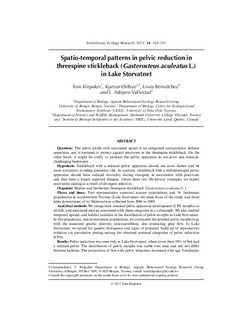Spatio-temporal patterns in pelvic reduction in threespine stickleback (Gasterosteus aculeatus L.) in Lake Storvatnet
Peer reviewed, Journal article
Permanent lenke
http://hdl.handle.net/11250/134524Utgivelsesdato
2012Metadata
Vis full innførselSamlinger
Originalversjon
Klepaker, T., Østbye, K., Bernatchez, L., & Vøllestad, L. A. (2012). Spatio-temporal patterns in pelvic reduction in threespine stickleback (Gasterosteus aculeatus L.) in Lake Storvatnet. Evolutionary Ecology Research, 14(2), 169-191Sammendrag
Questions: The pelvic girdle with associated spines is an integrated anti-predator defence
apparatus, and is assumed to protect against piscivores in the threespine stickleback. On the
other hand, it might be costly to produce the pelvic apparatus in ion-poor and mineralchallenging
freshwater.
Hypothesis: Stickleback with a reduced pelvic apparatus should use more shelter and be
more nocturnal, avoiding predation risk. In contrast, stickleback with a well-developed pelvic
apparatus should have reduced mortality during ontogeny in encounters with piscivores
and thus have a longer expected lifespan. Given these two life-history strategies, we expect
assortative mating as a result of divergent selection.
Organism: Marine and freshwater threespine stickleback (Gasterosteus aculeatus L.).
Places and times: Two representative ancestral marine populations and 36 freshwater
populations in northwestern Norway (Lake Storvatnet, the main focus of the study, and three
lakes downstream of it). Material was collected from 2006 to 2009.
Analytical methods: We categorized nominal pelvic apparatus development (CPS morphs) in
all fish, and measured metrics associated with these categories in a subsample. We also studied
temporal, spatial, and habitat variation in the distribution of pelvic morphs in Lake Storvatnet.
In this population, and downstream populations, we contrasted the detailed pelvic morphology
with the measured genetic diversity (microsatellites), also estimating gene flow. In Lake
Storvatnet, we tested for genetic divergence and signs of potential build-up of reproductive
isolation via assortative mating among the observed nominal categories of pelvic reduction
(CPS).
Results: Pelvic reduction was seen only in Lake Storvatnet, where more than 50% of fish had
a reduced pelvis. The distribution of pelvic morphs was stable over time and did not differ
between habitats. The proportion of fish with pelvic reduction decreased with age. Freshwater stickleback tended to have a smaller pelvis than marine fish. The Lake Storvatnet stickleback
were genetically differentiated from the downstream Lake Gjerhaugsvatn population, and both
of these were different from the marine populations, with little gene flow among populations. No
apparent genetic structure was found between CPS morphs within Lake Storvatnet. However,
genetic factorial correspondence axes were significantly correlated with pelvic principal
component axes in Lake Storvatnet, suggesting some phenotype × genetic association.
Conclusion: The weak association between phenotypes and genetic structure observed in
this study may reflect the build-up of early steps of reproductive isolation. Given time, such
mechanisms may lead to the evolution of assortative mating, which may drive adaptive pelvic
morphs (niche peaks), further resulting in genetically divergent populations and pelvic morphs.
